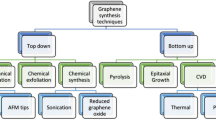Abstract
The emergence of 2-dimensional (2D) materials could herald numerous advanced scientific methodologies for both fundamental and applied research. These ultrathin materials can be functionalized and, thus, have the potential to make new devices and sensors that are both highly efficient and sensitive. In addition to being mechanically robust, the 2D materials can be engineered to provide sensor architectures that further increase their inherent high surface area by creating 3D geometries using layer by layer assembly to make stacked devices that could potentially be transparent. The increased sensor surface area would deliver increased signal-to-noise and sensitivity. Here highly sensitive and selective electrochemical detection of bio-analytes using some of engineered 2D materials such as graphene nano-ribbons, fluorinated graphene, and molybdenum disulfide is presented. It is found that surface moieties, defects and surface charges in these ultra-thin layers result in enhanced electron transfer kinetics between the electrodes and biomolecules. This in turn results in an oxidation or reduction of biomolecules with a high peak current, indicating the possible uses of 2D materials for various point-of-care devices. A novel stable 3D electrode geometry has been found to have enhanced heterogeneous electron transfer properties compared to 2D electrodes and provides evidence that electrode geometry and surface area could significantly impact the performance of biosensors.
Similar content being viewed by others
References
S. Boopati, T. N. Narayanan, and S. S. Kumar, Nanoscale 6, 10140 (2014).
R. L. McCreery, Chem. Rev. 108, 2646 (2008).
L. Song, Z. Liu, A. L. M. Reddy, N. T. Narayanan, J. T.- Tijerina, J. Peng, G. Gao, J. Lou, R. Vajtai, and P. M. Ajayan, Adv. Mater. 24, 4878 (2012).
T. V. Vineesh, S. Alwarappan, and T. N. Narayanan, Chem. Comm. (Under Review) (2014).
A. Mathkar, T. N. Narayanan, L. B. Alemany, P. Cox, P. Nguyen, G. Gao, P. Chang, R. R. Aburto, S. A. Mani, and P. M. Ajayan, Part. Part. Syst. Charact. 30, 266 (2013).
D. K. James and J. M. Tour, Macromol. Chem. Phys. 213, 1033 (2012).
T. N. Narayanan, C. S. R. Vusa, and S. Alwarappan, Nanotechnology, 25, 335702 (2014).
Acknowledgments
TNN thanks the support received from Dr. S.Alwarappan, T. V. Vineesh, S. Boopati and Dr. S Senthil Kumar during the execution of this work. T. N. N. also acknowledges the funding support from DST, India in the form of Fast Track fellowship [SB/FTP/PS-084/2013].
Author information
Authors and Affiliations
Corresponding author
Rights and permissions
About this article
Cite this article
Narayanan, T.N., Ajayan, P.M., Viswanathan, S. et al. Engineered 2D Materials for Efficient Biosensors. MRS Online Proceedings Library 1725, 41–49 (2014). https://doi.org/10.1557/opl.2015.202
Published:
Issue Date:
DOI: https://doi.org/10.1557/opl.2015.202




